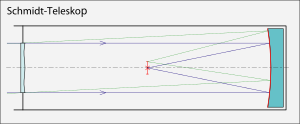Schmidt camera


A Schmidt camera is an astronomical camera designed to provide wide fields of view with limited aberrations. Other similar designs are the Wright Camera and Lurie-Houghton telescope.
Invention and design
The Schmidt camera was invented by Bernhard Schmidt in 1930[1]. Its optical components are an easy-to-make spherical primary mirror, and an aspherical correcting lens, known as a corrector plate, located at the center of curvature of the primary mirror. The film or other detector is placed inside the camera, at the prime focus. The design is noted for allowing very fast focal ratios, while controlling coma and astigmatism.
Schmidt cameras have very strongly curved focal planes, thus requiring that the film, plate, or other detector be correspondingly curved. In some cases the detector is made curved; in others flat media is mechanically conformed to the shape of the focal plane through the use of retaining clips or bolts, or by the application of a vacuum. A field flattener, -in its simplest form, a planoconvex lens in direct contact with the film- is sometimes used. Systems with such lens are called Schmidt-Väisälä camera.
Applications
The Schmidt camera is typically used as a survey instrument, for research programs in which a large amount of sky must be covered. These include astronomical surveys, comet and asteroid searches, and nova patrols.
In addition, Schmidt cameras and derivative designs are frequently used for tracking artificial earth satellites.
Starting in the early 1970s, Celestron marketed an 8-inch Schmidt Camera. The camera was focused in the factory and was made of materials with low expansion coefficients so it would never need to be focused in the field. Early models required the photographer to cut and develop individual frames of 35mm film as the film holder could only hold one frame of film. About 300 Celestron Schmidt Cameras were produced.
The Schmidt system was popular, used in reverse, for television projection systems. Large Schmidt projectors were used in theaters but systems as small as 8-inches were made for home use and other small venues.
Arguably the most famous and productive Schmidt camera is the Oschin Schmidt Telescope at Palomar Observatory. It was used for the National Geographic Society - Palomar Observatory Sky Survey (POSS), the POSS-II survey, the Palomar-Leiden (asteroid) Surveys, and other projects. The telescope used in the Lowell Observatory Near-Earth-Object Search (LONEOS) is also a Schmidt camera. The Schmidt telescope of the Karl Schwarzschild Observatory is the largest Schmidt camera of the world.
Derivative designs
Lensless Schmidt
Prior to Schmidt's design, the solution to spherical aberration was to place an aperture stop at the center of curvature of the mirror, stopping the aperture to f/10. This removes spherical aberration while preserving the wide field of the short focal-length mirror. However, it does so at the cost of light-gathering ability. Although this solution was well-known long before Bernhard Schmidt invented his corrector plate, the design is known as a "lensless Schmidt".
Schmidt-Väisälä
Prof. Yrjö Väisälä originally designed an "astronomical camera" similar to Bernhard Schmid's "Schmidt camera", but the design was unpublished. Väisälä did mention it in lecture notes in 1924 with a footnote: "problematic spherical focal plane". Once Väisälä saw Schmidt's publication, he promptly went ahead and solved the field-flattening problem in Schmidt's design by placing a doubly-convex lens slightly in front of the film holder. This resulting system is known as: Schmidt-Väisälä camera or sometimes as Väisälä camera.
Baker-Schmidt
In 1940, James Baker of Harvard University modified the Schmidt camera design to include a convex secondary mirror, which reflected light back toward the primary. The photographic plate was then installed near the primary, facing the sky. This variant is called the Baker-Schmidt camera.
Baker-Nunn
The Baker-Nunn design, by Dr. Baker and Joseph Nunn, replaced the Baker-Schmidt camera's corrector plate with a small triplet corrector lens closer to the focus of the camera. A dozen Baker-Nunn cameras with 20-inch aperatures – each weighing 3.5 tons – were used by the Smithsonian Astrophysical Observatory to track artificial satellites from the late 1950s to mid 1970s.[1]
Mersenne-Schmidt
The Mersenne-Schmidt camera consists of a concave paraboloidal primary mirror, a convex spherical secondary mirror, and a concave spherical tertiary mirror.
Schmidt-Newtonian
The addition of a flat secondary mirror at 45° to the optical axis of the Schmidt design creates a Schmidt-Newtonian telescope.
Schmidt-Cassegrain
The addition of a convex secondary mirror to the Schmidt design directing light through a hole in the primary mirror creates a Schmidt-Cassegrain telescope.
The last two designs are popular with telescope manufacturers because they are compact and use simple spherical optics.
